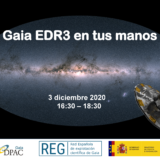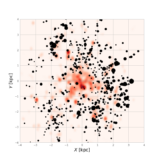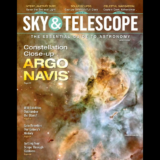Gaia EDR3 bulk catalogue available in a better compression format
The Gaia group at the University of Barcelona (IEEC – ICCUB), in cooperation with DAPCOM Data Services (a technological spin-off company of the UPC and the UB), has published an alternative copy of the bulk data files from Gaia EDR3 – the Early Data Release 3 from Gaia. Gaia EDR3 was published yesterday, 3rd December 2020. Besides the on-line catalogue, bulk CSV files were also made available for download – an interesting option for exhaustive analyses. Such files are officially offered in “csv.gz” format, that is, compressed with the widely known gzip...
read moreGaia EDR3 en tus manos
Now you can enjoy the conference Gaia, our Galaxy in your hands by our researchers, Mercè Romero and Josep Manel Carrasco that was given last Thursday, December 3rd at 19.00 via Youtube Live, the conference is in Spanish. The European Space Agency’s (ESA) Gaia satellite is revolutionizing the astronomy, providing unprecedented clues about the origin and evolution of our Galaxy, the Milky Way. Coinciding with the third publication of mission data, with more than 1.8 billion objects, we describe the mission, review Gaia’s strategy for observing the Universe, and analyse the latest...
read moreGaia EDR3 en tus manos
Coloquio-tertulia sobre los datos de Gaia-eDR3 Jueves 3 de diciembre, 16:30 a 18:30 Video del acto en YouTube Objetivos de la reunión A las 12:00 del próximo 3 de diciembre se hará pública la tercera entrega de datos de la misión Gaia, sin duda otro valioso hito esperado por la comunidad astronómica y, muy en particular, por nuestra comunidad REG. El equipo DPAC España queremos compartir, mediante este coloquio-tertulia, las lecciones aprendidas durante las fases de tratamiento de los datos y la obtención de los primeros resultados científicos publicados en los “demonstration papers”. Os...
read moreGaia Mission App Updated!!!
Delivering interesting and scientifically accurate information to the general public is a challenge. The Gaia Mission app is an interactive application for mobile devices designed to discover the details of the Gaia mission. All aspects of the mission are covered, from technical issues to the science behind it. The application is designed to keep users engaged during the whole mission and build interest on the mission achievements while stimulating enthusiasm for astronomy. iOS and Android support for both phones and tablets Combined, the two platforms capture 96% global market...
read more582 new open clusters in the Galactic disc of our Milky Way
Alfred Castro-Ginard et al. have found 582 new open clusters, using the data from the second release of the Gaia mission. Open clusters are groups of gravitationally bound stars, that were formed in the same event – so they have the same chemical composition and age – and share a common position and proper motion. Those open clusters are fundamental objects in galaxies, and key for the understanding of the structure and evolution of the Milky Way. While young open clusters allow researchers to trace the star forming regions and to understand the star forming mechanisms, intermediate and old...
read moreTeresa Antoja and Roger Mor interviewed at the Sky & Telescope magazine
Our astronomers Teresa Antoja and Roger Mor appear in this month’s edition of the Sky & Telescope magazine. They talk about the Gaia mission and how its data releases have been broadening the knowledge about our Milky Way. In the piece ““Data from the Gaia Spacecraft are unveiling the Milky Way’s tumultuous past”, Mor talks about his findings on the Milky Way’s stelar baby boom. Antoja says to the magazine “ Most of usare very lucky to be in this place and at this time. This topic in general, galactic dynamics, this will be the Golden age”. She has recently published...
read more









